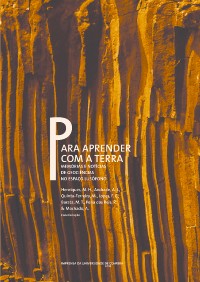Please use this identifier to cite or link to this item:
https://hdl.handle.net/10316.2/31407| DC Field | Value | Language |
|---|---|---|
| dc.contributor.author | Rocha, J. | |
| dc.contributor.author | Henriques, M. H. | |
| dc.contributor.author | Brilha, J. | |
| dc.date.accessioned | 2014-06-19T16:36:04Z | |
| dc.date.accessioned | 2020-09-18T16:45:34Z | - |
| dc.date.available | 2014-06-19T16:36:04Z | |
| dc.date.available | 2020-09-18T16:45:34Z | - |
| dc.date.issued | 2012 | - |
| dc.identifier.isbn | 978-989-26-0533-3 (PDF) | |
| dc.identifier.uri | https://hdl.handle.net/10316.2/31407 | - |
| dc.description.abstract | The Cape Mondego (Portuguese west coast) is internationally known for the stratigraphic relevance of its outcrops, due to the establishment of the Global Boundary Stratotype Section and Point (GSSP) for the base of the Bajocian stage and the Auxiliary Section and Point (ASSP) for the base of the Bathonian stage. Based on the exceptional quality of the geological record, and on its high scientific and educational values, this area was included, in 2007, in the National Network of Protected Areas, as a Natural Monument. The creation of a geological based protected area must be associated with geoconservation strategies aiming the valuation of its geological features as well as its conservation and preservation. But despite being a Natural Monument and included in the national inventory of geological heritage, until now the outcrops of Cape Mondego have not been assessed for their vulnerability. The vulnerability assessment of geosites allows the establishment of priority conservation and valuing strategies. In this paper we present the results of the anthropic and natural vulnerability assessment of geosites in Cape Mondego with the aim of contributing to the conservation and valuation of the geological heritage of this Natural Monument. | eng |
| dc.description.abstract | O Cabo Mondego (costa ocidental Portuguesa) é conhecido internacionalmente pela importância estratigráfica dos seus afloramentos, nomeadamente pelo estabelecimento de um estratotipo de limite – o Global Boundary Stratotype Section and Point (GSSP) para a base do Bajociano, – e de um estratotipo auxiliar – o Auxiliary Section and Point (ASSP) para a base do Batoniano. Com base na excecional qualidade do registo geológico, bem como na sua importância científica e no seu valor didático, os afloramentos do Cabo Mondego foram classificados como Monumento Natural em 2007, integrando a Rede Nacional de Áreas Protegidas. A criação de uma área protegida de cariz geológico deve ser acompanhada de estratégias de geoconservação que visem a divulgação dos seus elementos geológicos, bem como de medidas focadas na sua conservação e preservação. Mas, apesar de ter sido classificado como Monumento Natural e de ter sido incluído no inventário nacional de património geológico, os afloramentos do Cabo Mondego não tinham sido, até agora, objeto de uma avaliação da vulnerabilidade dos geossítios que neles se incluem. A avaliação da vulnerabilidade dos geossítios permite definir a prioridade na aplicação de estratégias de conservação e de valorização. No presente trabalho apresentam‑se os resultados obtidos de um estudo de avaliação da vulnerabilidade dos geossítios definidos no Cabo Mondego, face às atividades antrópicas e naturais, com o objetivo de contribuir par | por |
| dc.language.iso | por | - |
| dc.publisher | Imprensa da Universidade de Coimbra | por |
| dc.relation.ispartof | http://hdl.handle.net/10316.2/24405 | por |
| dc.rights | open access | - |
| dc.subject | Cape Mondego Natural Monument (Portugal ) | eng |
| dc.subject | Geological Heritage | eng |
| dc.subject | Vulnerability | eng |
| dc.subject | Geosites | eng |
| dc.subject | Monumento Natural do Cabo Mondego (Portugal) | por |
| dc.subject | Património Geológico; | por |
| dc.subject | Vulnerabilidade | por |
| dc.subject | Geossítios | por |
| dc.title | O património geológico do Cabo Mondego (Portugal): avaliação da vulnerabilidade dos geossítios | por |
| dc.title.alternative | The geological heritage of Cape Mondego (Portugal): geosite vulnerability assessment | eng |
| dc.type | bookPart | por |
| uc.publication.firstPage | 351 | - |
| uc.publication.lastPage | 361 | - |
| uc.publication.location | Coimbra | por |
| dc.identifier.doi | 10.14195/978-989-26-0533-3_37 | - |
| uc.publication.digCollection | PB | por |
| uc.publication.orderno | 37 | - |
| uc.publication.area | Ciências Naturais | por |
| uc.publication.bookTitle | Para aprender com a Terra: memórias e notícias de Geociências no espaço lusófono | - |
| uc.publication.manifest | https://dl.uc.pt/json/iiif/10316.2/31407/218721/manifest?manifest=/json/iiif/10316.2/31407/218721/manifest | - |
| uc.publication.thumbnail | https://dl.uc.pt/retrieve/11296104 | - |
| uc.publication.parentItemId | 52123 | - |
| uc.itemId | 71887 | - |
| item.grantfulltext | open | - |
| item.fulltext | With Fulltext | - |
| Appears in Collections: | Para aprender com a Terra: memórias e notícias de Geociências no espaço lusófono | |
Files in This Item:
| File | Description | Size | Format | |
|---|---|---|---|---|
| 37-para_aprender_com_a_terra_v.f..pdf | 737.45 kB | Adobe PDF |  |
Items in DSpace are protected by copyright, with all rights reserved, unless otherwise indicated.
